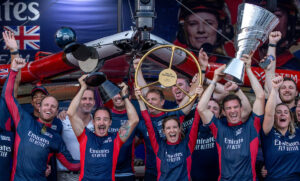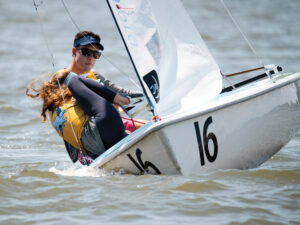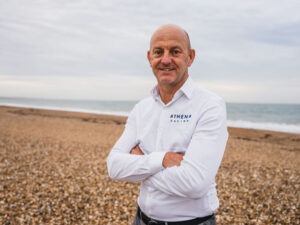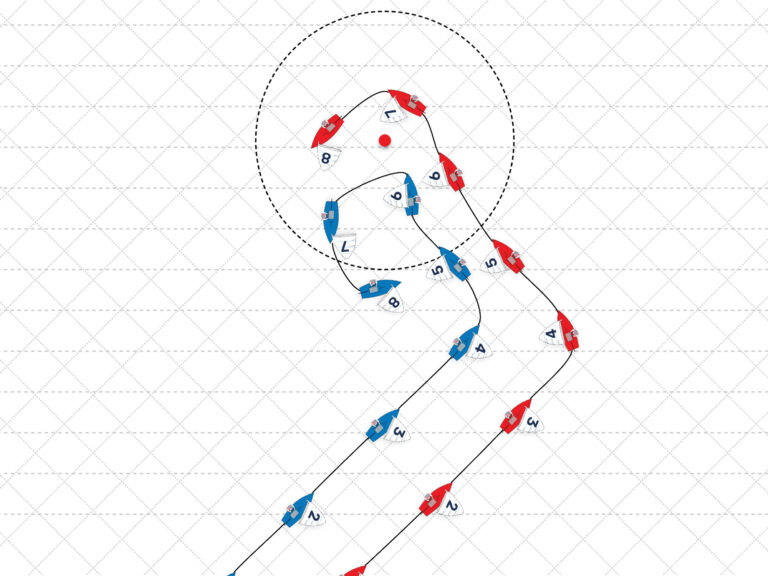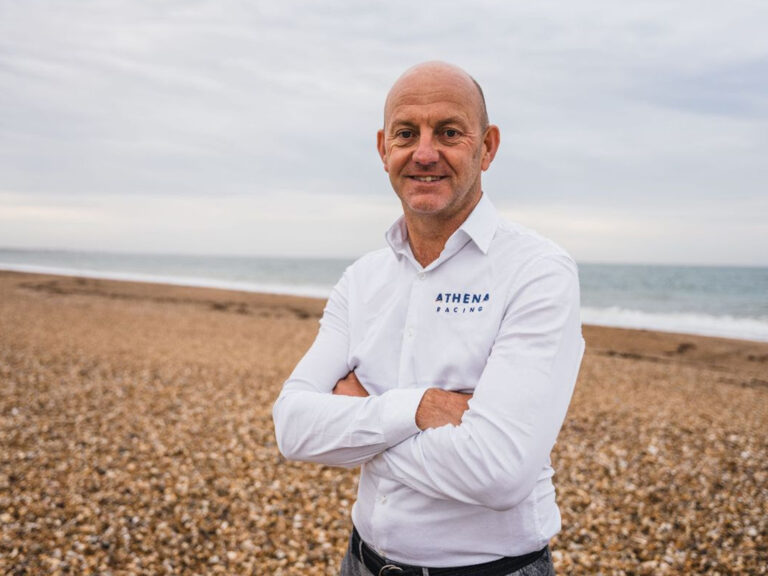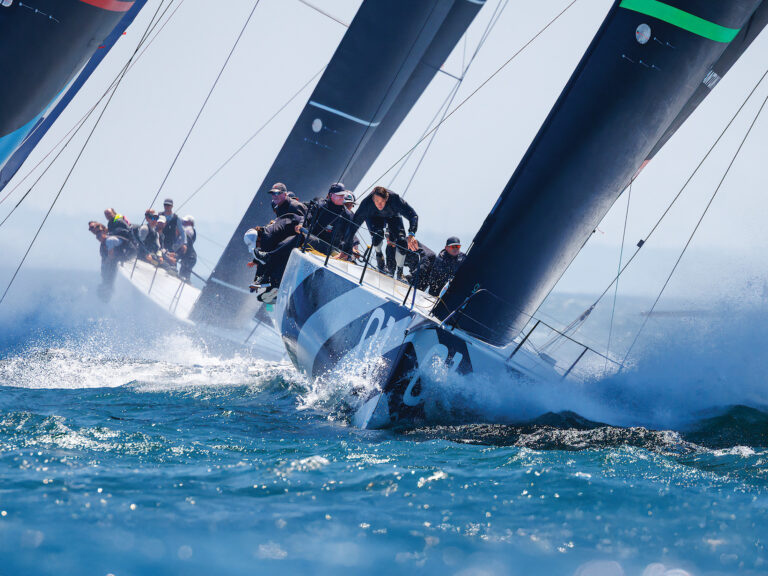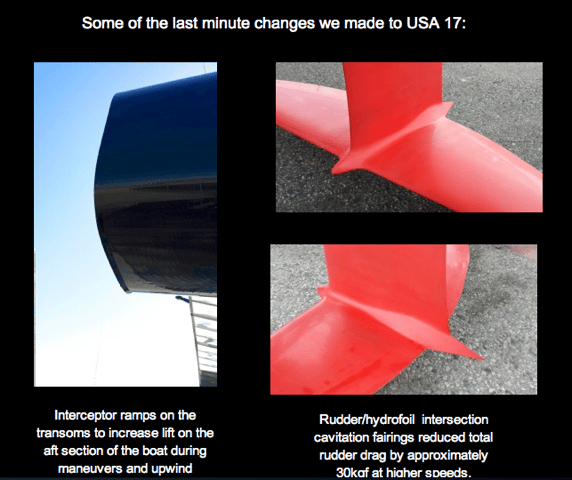
Bieker Rudder Spear
ON THURSDAY SEPT. 12, the Dogpatch Café near Pier 80 in San Francisco was filled with guys in black polo shirts and jerseys. The event was Oracle Team USA’s shore team manager Mark “Tugboat” Turner’s birthday, but the mood was a bit somber. OTUSA was down 6 to 1 having lost two more races on this Thursday, September 12, to Emirates Team New Zealand. Some guys were wondering what they would do next as they felt the America’s Cup slipping from their grasp. The following morning, Friday the 13th, bookies in Las Vegas were rumored laying odds of about 700-to-1 against OTUSA winning the Cup.
Fast forward to October 11, and the first thing Paul Bieker asks me when I meet him at the Anacortes YC for a presentation on the 34th America’s Cup comeback win was, “Weren’t you there at that come-to-Jesus gathering at the Dogpatch?”
“Yes,” I acknowledge, but think to myself, “If Jesus was at the Dogpatch that evening he was pretty quiet.”
“Well, the next morning was the beginning of the comeback,” says Bieker. “We admitted that we had a very long way to go to win, but that we just did not want to be so totally embarrassed in defeat.”
From then on, he added, any idea put on the table got consideration.
By September 20, the comeback was gaining steam, and Bieker sent an email on that same day stating, “It has been fun when the design team loosens up a bit. Done some funny/cool stuff.”
Following BMW Oracle’s Cup win in Valencia, Spain in 2010, Oracle hired the core of the Alinghi design team, including Dirk Kramers. Perhaps Oracle speculated that joining the two design teams from Valencia would provide the best large multihull brain trust to design the upcoming AC72. Paul Bieker was released while others came in from the Alinghi design squad, but when problems developed, OTUSA invited him back to have a look at the foils, as he is regarded as a foremost expert in foil design. Bieker is a keen marine design engineer, a world champion in the I-14 class, and a unique combination of designer, sailor, and one unafraid of getting his hands into epoxy and carbon fiber.
“On one of my first rides on OTUSA’s AC72, when we hit about 40 knots, the daggerfoil cavitation became severe,” says Bieker. “It got so wild I began to think about my family responsibilities and backed away to a safer distance. Unfortunately, it was way too late to begin an analysis to address this problem.”
Bieker then began to focus more on the rudder foils. They seemed lightly loaded as the boat sailed to weather, which was the point of sail where Emirates Team New Zealand’s boat excelled. The decision was made to change the settings on the wing sail to shift more power to the leech:
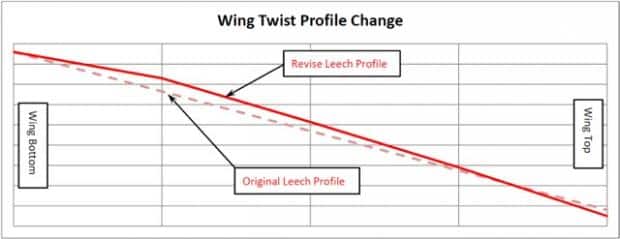
This led to an increase in the mainsheet load from 1 to 1.7 tons. Simultaneously, loads on the rudder foils increased. As the loads on the rudder increased, and after noticing that paint was wearing away from parts of the horizontal foil, especially at its joint with the vertical rudder strut, Bieker realized the water was actually vaporizing at higher speeds at the base of the strut, stripping off the paint. The net result was cavitation, which caused more drag.
During one of many sleepless nights since the Cup started on September 7, Bieker pulled up data onto a computer showing the area of the cavitation. Without waiting for further analysis, he drew a line around this area. Then he and OTUSA boatbuilder Manu Armenazas crafted what he called the “stinger,” a spear-like structure protruding fore and aft from the area of worst cavitation. With no time to test, the concept was implemented with some designers commenting that the forward protrusion was unnecessary. Bieker, nevertheless, stuck with his design and attached the stinger. Meanwhile, the design went to a super computer in Italy for flow analysis. When it came back, the analysis yielded two stunning results: the forward protrusion was necessary, and the stinger was adding four-tenths of a knot downwind.
That wasn’t the only change, however, that made differences in the overall performance, says Bieker.
“There were a number of small changes, like the interceptor ramps. At the stern of each hull, I added a ridge to force the flow down and lift the stern more quickly out of the water. We kind of added the fairing in front of the interceptor ridges so they did not look like bare strips to the sailors, but the effect was the same.”
The near capsize of Emirates Team New Zealand in Race 8 was a critical point in the performance of the OTUSA sailors. Bieker believes that OTUSA, in being able to hang with the Kiwis upwind in that race, were finally putting pressure on them.
As he watched the replay of the near capsize on the Anacortes YC’s big screen, he says, “See … they had to pull off a pretty good leebow tack and it fell apart right there. I am still amazed they did not capsize. By this time in the regatta, our guys had really learned to stay on the foils both through the jibes and upwind.”
We watched another segment of racing, and for a moment the Kiwi catamaran floated high in the air on her foils. “We learned that high is not fast, but just having the leeward hull kissing the surface is fast,” he says as the Kiwi boat settles to a more normal height.
I later ask him, “If you had to pick three of the most significant factors that powered this comeback what would they be?”
“Rethinking the trim of the wing sail to develop more power and put the effort further aft on the boat was a big improvement, followed by the crew work when they mastered staying on the foils both though jibes and upwind,” he says. “Third, we picked up performance in modifying the foils. It was a series of adjustments in all areas, from people who would just not give up, that achieved the speed changes in the boat.”
[Editor’s note: During his one-on-one interview with SW contributor Gary Jobson, OTUSA skipper Jimmy Spithill also hinted at other significant changes, including adding more weight to the starboard hull, which allowed the team foil more efficiently on starboard tack, and moving weight further aft in the boat. For the full video of Spithill’s talk at the Sailing World/Cruising World Seminar Series presented by B&G, click here.]


